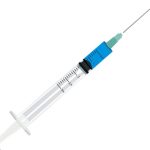1. Understanding Non-Surgical Rhinoplasty
Non-surgical rhinoplasty, also known as a liquid nose job, is a minimally invasive procedure that uses dermal fillers to reshape and enhance the nose without the need for surgery. This approach is an excellent option for individuals looking to make subtle changes to their nasal appearance without undergoing a traditional rhinoplasty.
How Does Non-Surgical Rhinoplasty Work?
The procedure involves injecting hyaluronic acid-based fillers into specific areas of the nose to smooth out bumps, enhance symmetry, or lift the nasal tip. A skilled provider carefully places the filler to create a more balanced and harmonious appearance.
Benefits of Non-Surgical Rhinoplasty
- Minimally Invasive: No incisions or general anesthesia are required.
- Quick Procedure: Typically takes 15-30 minutes with minimal downtime.
- Immediate Results: Visible improvement right after treatment.
- Reversible: Hyaluronic acid fillers can be dissolved if needed.
- No Long Recovery Period: Most patients resume normal activities immediately.
Procedure Details
The process begins with a consultation where your provider assesses your facial structure and discusses your aesthetic goals. During the treatment, small amounts of filler are injected into targeted areas using a fine needle. Mild swelling or redness may occur but usually subsides within a few hours.
Longevity of Results
The effects of non-surgical rhinoplasty typically last between 6 to 18 months, depending on the type of filler used and individual metabolism. Since the results are temporary, touch-up treatments are necessary to maintain the desired look.
Comparison: Non-Surgical vs. Surgical Rhinoplasty
| Non-Surgical Rhinoplasty | Surgical Rhinoplasty | |||||||||||||||||||||||||||||||||||||||||||||||||||||||||||||||||||||
|---|---|---|---|---|---|---|---|---|---|---|---|---|---|---|---|---|---|---|---|---|---|---|---|---|---|---|---|---|---|---|---|---|---|---|---|---|---|---|---|---|---|---|---|---|---|---|---|---|---|---|---|---|---|---|---|---|---|---|---|---|---|---|---|---|---|---|---|---|---|---|
| Procedure Type | Minimally invasive (dermal fillers) | Surgical intervention | ||||||||||||||||||||||||||||||||||||||||||||||||||||||||||||||||||||
| Anesthesia | No anesthesia required | General anesthesia or local anesthesia with sedation | ||||||||||||||||||||||||||||||||||||||||||||||||||||||||||||||||||||
| Downtime | Little to none | A few weeks of recovery time | ||||||||||||||||||||||||||||||||||||||||||||||||||||||||||||||||||||
| Permanence | Temporary (6-18 months) | Permanent results | ||||||||||||||||||||||||||||||||||||||||||||||||||||||||||||||||||||
| Candidates | Mild to moderate nasal imperfections | Dramatic structural changes needed | ||||||||||||||||||||||||||||||||||||||||||||||||||||||||||||||||||||
Co
2. Surgical Rhinoplasty: What to ExpectIf youre looking for a permanent solution to enhance the shape and function of your nose, surgical rhinoplasty might be the right choice. Unlike non-surgical options that offer temporary results, traditional rhinoplasty provides long-lasting changes through precise surgical techniques. Here’s what you need to know before considering this procedure. Surgical TechniquesSurgical rhinoplasty involves reshaping the nose by altering bone, cartilage, or both. There are two main approaches: Open RhinoplastyThis technique involves making an incision on the columella (the strip of tissue between the nostrils) to provide full visibility and access to the nasal structures. Its often used for more complex cases requiring significant reshaping. Closed RhinoplastyAll incisions are made inside the nostrils, leaving no visible scars. This method is typically used for minor adjustments and has a slightly shorter recovery time. Recovery TimelineThe recovery process varies from person to person, but here’s a general timeline of what you can expect:
The Benefits of Permanent ReshapingSurgical rhinoplasty provides lasting results that don’t require touch-ups like non-surgical options. Whether you want to refine the bridge, adjust the tip, or correct breathing issues, this procedure offers comprehensive changes tailored to your goals.
3. Comparing Results: Non-Surgical vs. SurgicalWhen deciding between non-surgical and surgical rhinoplasty, one of the most important factors to consider is the final result. Both procedures can enhance the appearance of your nose, but they differ significantly in terms of permanence, refinement, and limitations. Permanence: Temporary vs. Long-Lasting ResultsA key distinction between these two options is how long the results last. Non-surgical rhinoplasty typically uses dermal fillers to reshape the nose, which means the effects are temporary. Depending on the type of filler used, results usually last between 6 months to 2 years before requiring maintenance treatments. On the other hand, surgical rhinoplasty offers permanent changes. Since this procedure involves modifying the bone and cartilage structure, the results do not fade over time. While minor changes may occur due to aging or healing processes, a surgical rhinoplasty provides a long-lasting transformation. Refinement: How Precise Can the Changes Be?If youre looking for small refinements or subtle contouring, non-surgical rhinoplasty can be an excellent option. Fillers can smooth out bumps, lift the nasal tip, or create a more symmetrical look without invasive surgery. Surgical rhinoplasty, however, allows for more comprehensive changes. Whether you need to reduce the size of your nose, correct breathing issues, or make structural adjustments, surgery provides greater precision and control over reshaping your nasal structure. Limitations: What Can and Cannot Be Achieved?While non-surgical rhinoplasty is effective for minor enhancements, it has its limitations. It cannot reduce nose size or correct significant structural issues like a deviated septum. Additionally, since fillers add volume rather than remove it, those seeking a smaller nose may not achieve their desired outcome with this method. Surgical rhinoplasty has fewer limitations in terms of reshaping and functional corrections. However, it does come with a longer recovery time and higher costs compared to its non-surgical counterpart. Quick Comparison: Non-Surgical vs. Surgical Rhinoplasty
4. Cost and Recovery ConsiderationsWhen deciding between non-surgical and surgical rhinoplasty, cost and recovery time are major factors to consider. Both procedures have different price points and healing processes, so it’s essential to understand what to expect before making a decision. Cost ComparisonThe cost of rhinoplasty can vary based on location, provider expertise, and the complexity of the procedure. Generally, non-surgical rhinoplasty is more affordable than surgical rhinoplasty because it does not require anesthesia or an operating room.
Recovery Time & DowntimeThe recovery process for these two procedures is vastly different. Non-surgical rhinoplasty has minimal downtime, while surgical rhinoplasty requires a more extended healing period.
Post-Treatment CareNon-Surgical Rhinoplasty:
Surgical Rhinoplasty:
If budget and quick recovery are your priorities, non-surgical rhinoplasty might be the better option. However, if you’re looking for permanent results and are willing to invest in a longer recovery period, surgical rhinoplasty could be worth considering. Understanding these differences will help you choose the right procedure based on your needs and expectations. 5. Which Option Is Right for You?Choosing between non-surgical and surgical rhinoplasty depends on several factors, including your aesthetic goals, lifestyle, and long-term expectations. Each option has its own benefits and limitations, so understanding what aligns best with your needs is essential. Aesthetic GoalsYour desired outcome plays a significant role in determining the right procedure. If youre looking for minor refinements such as smoothing out a small bump or adding slight definition to the bridge of your nose, a non-surgical rhinoplasty might be the perfect solution. However, if you want a more dramatic change, such as reducing the size of your nose or correcting structural issues, a surgical rhinoplasty is likely the better choice. Lifestyle ConsiderationsYour daily routine and lifestyle can also influence your decision. If you have a busy schedule and cant afford extended downtime, a non-surgical rhinoplasty offers immediate results with little to no recovery time. On the other hand, if youre prepared for a longer healing process to achieve permanent changes, surgery might be worth considering. Long-Term ExpectationsIts important to think about how long you want your results to last. Non-surgical rhinoplasty results typically last between 6 months to 2 years, depending on the type of filler used. If youre open to maintenance treatments, this could be a good option. However, if you prefer a one-time procedure with lasting effects, surgical rhinoplasty provides permanent changes. Comparison Table: Non-Surgical vs. Surgical Rhinoplasty
Your Decision: What’s Best for You?If youre unsure which option is right for you, consulting with an experienced provider can help you make an informed decision. They can assess your goals, facial structure, and medical history to recommend the best approach tailored to your needs. |



